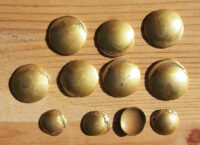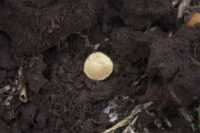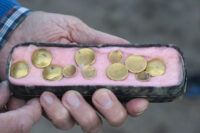 A group of 41 Celtic gold cup-shaped coins have been discovered near the village of Baitz in Brandenburg, northeastern Germany. These are the first and only Celtic gold coins ever discovered in Brandenburg.
A group of 41 Celtic gold cup-shaped coins have been discovered near the village of Baitz in Brandenburg, northeastern Germany. These are the first and only Celtic gold coins ever discovered in Brandenburg.
Rainbow cups are bowl-shaped coins made of precious metals that are found in the territory of the Celtic La Tène culture of central Europe. (They received their moniker because they were often discovered by farmers  when ploughing their fields after heavy rain, so a folk legend sprang up that gold cups would be found wherever a rainbow had touched the ground.) They are often decorated with Celtic iconography. The ones discovered in Baitz are smooth, with no decoration on the surface. It is the second largest hoard of smooth rainbow cups ever found.
when ploughing their fields after heavy rain, so a folk legend sprang up that gold cups would be found wherever a rainbow had touched the ground.) They are often decorated with Celtic iconography. The ones discovered in Baitz are smooth, with no decoration on the surface. It is the second largest hoard of smooth rainbow cups ever found.
There was no Celtic population in Brandenburg — a settlement from the early Germanic Jastorf culture occupied the site — so these precious objects likely reached the settlement over Iron Age trade networks.
 They were discovered by Wolfgang Herkt, an officially appointed volunteer archaeologist trained and overseen by the Brandenburg State Office for the Preservation of Monuments and Archaeological State Museum (BLDAM). He first came across a group of 11 coins, and a follow-up excavation turned up another 30 for a total of 41 gold coins. There are also silver and copper cups. The bronzes may have been counterfeits; bronze coated in a thin layer of gold have been found before in cup hoards, a deliberate deception to pass off false coinage as the genuine article.
They were discovered by Wolfgang Herkt, an officially appointed volunteer archaeologist trained and overseen by the Brandenburg State Office for the Preservation of Monuments and Archaeological State Museum (BLDAM). He first came across a group of 11 coins, and a follow-up excavation turned up another 30 for a total of 41 gold coins. There are also silver and copper cups. The bronzes may have been counterfeits; bronze coated in a thin layer of gold have been found before in cup hoards, a deliberate deception to pass off false coinage as the genuine article.
The rainbow cups are scheduled to go on display at the Brandenburg State Archaeological Museum in the spring.
